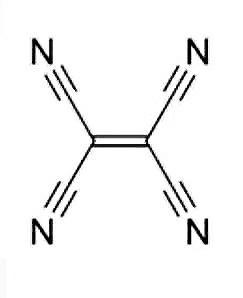
The number of sigma bonds in tetra cyano ethylene is ______.
(A) 7
(B) 6
(C) 5
(D) 9
Answer
140.4k+ views
Hint: As the name suggests, the compound tetra cyano ethylene contains four cyano groups and one ethylene group bonded with each other in a specific arrangement. Mostly, the name of the compound tells us about the composition but this is not applicable every time.
Complete step by step solution:
There are two types of covalent bonds between atoms namely sigma bond and a pi bond.
Sigma bonds (σ-bond) are the strongest type of covalent bonds. They are formed when atomic orbitals between atoms overlap head-on with each other. A σ-bond is symmetrical with respect to rotation about the bond axis of the atoms. Common forms of sigma bonds are of four types i.e.
Pi bonds (π bonds) are covalent bonds where two lobes of an orbital on one atom laterally overlap with two lobes of an orbital on another atom. The electron density in each atomic orbital is zero at a shared nodal plane, passing through the two bonded nuclei. Pi Bonds can form in double and triple bonds but do not form in single bonds in most cases.
The compound tetra cyano ethylene also contains several sigma and pi bonds. To find the number, we have to look in its structure.

As we can see, there are four nitrogen atoms bonded with carbon with a triple bond. Also, two of the carbons are bonded with a double bond and both of them are connected with the carbon of cyanide with a single bond (two single bonds each).
We know, a triple bond contains 2 pi bonds and 1 sigma bond and a double bond contains a single sigma bond and a pi bond and a single bond contains only 1 sigma bond. Therefore:
Total number of sigma bond from four triple bonds are – 4
Total number of sigma bond from one double bond is – 1
Total number of sigma bond from four single bonds is – 4
Therefore, total number of sigma bonds are = 4+1+4 = 9
So, the correct answer is (D) “9”.
Note: In most of the cases, sigma bond is stronger than pi bonds but in some special cases pi bond may get stronger. One of these cases can be found in coordination compounds.
Complete step by step solution:
There are two types of covalent bonds between atoms namely sigma bond and a pi bond.
Sigma bonds (σ-bond) are the strongest type of covalent bonds. They are formed when atomic orbitals between atoms overlap head-on with each other. A σ-bond is symmetrical with respect to rotation about the bond axis of the atoms. Common forms of sigma bonds are of four types i.e.
Pi bonds (π bonds) are covalent bonds where two lobes of an orbital on one atom laterally overlap with two lobes of an orbital on another atom. The electron density in each atomic orbital is zero at a shared nodal plane, passing through the two bonded nuclei. Pi Bonds can form in double and triple bonds but do not form in single bonds in most cases.
The compound tetra cyano ethylene also contains several sigma and pi bonds. To find the number, we have to look in its structure.

As we can see, there are four nitrogen atoms bonded with carbon with a triple bond. Also, two of the carbons are bonded with a double bond and both of them are connected with the carbon of cyanide with a single bond (two single bonds each).
We know, a triple bond contains 2 pi bonds and 1 sigma bond and a double bond contains a single sigma bond and a pi bond and a single bond contains only 1 sigma bond. Therefore:
Total number of sigma bond from four triple bonds are – 4
Total number of sigma bond from one double bond is – 1
Total number of sigma bond from four single bonds is – 4
Therefore, total number of sigma bonds are = 4+1+4 = 9
So, the correct answer is (D) “9”.
Note: In most of the cases, sigma bond is stronger than pi bonds but in some special cases pi bond may get stronger. One of these cases can be found in coordination compounds.
Latest Vedantu courses for you
Grade 10 | MAHARASHTRABOARD | SCHOOL | English
Vedantu 10 Maharashtra Pro Lite (2025-26)
School Full course for MAHARASHTRABOARD students
₹33,300 per year
EMI starts from ₹2,775 per month
Recently Updated Pages
Types of Solutions - Solution in Chemistry

Difference Between Crystalline and Amorphous Solid

JEE Main Participating Colleges 2024 - A Complete List of Top Colleges

JEE Main Maths Paper Pattern 2025 – Marking, Sections & Tips

Sign up for JEE Main 2025 Live Classes - Vedantu

JEE Main 2025 Helpline Numbers - Center Contact, Phone Number, Address

Trending doubts
JEE Main 2025 Session 2: Application Form (Out), Exam Dates (Released), Eligibility, & More

JEE Main 2025: Derivation of Equation of Trajectory in Physics

JEE Main Exam Marking Scheme: Detailed Breakdown of Marks and Negative Marking

Learn About Angle Of Deviation In Prism: JEE Main Physics 2025

Number of sigma and pi bonds in C2 molecule isare A class 11 chemistry JEE_Main

Electric Field Due to Uniformly Charged Ring for JEE Main 2025 - Formula and Derivation

Other Pages
NCERT Solutions for Class 11 Chemistry Chapter 9 Hydrocarbons

NCERT Solutions for Class 11 Chemistry Chapter 7 Redox Reaction

JEE Advanced Marks vs Ranks 2025: Understanding Category-wise Qualifying Marks and Previous Year Cut-offs

NCERT Solutions for Class 11 Chemistry Chapter 5 Thermodynamics

Hydrocarbons Class 11 Notes: CBSE Chemistry Chapter 9

NCERT Solutions for Class 11 Chemistry In Hindi Chapter 1 Some Basic Concepts of Chemistry




